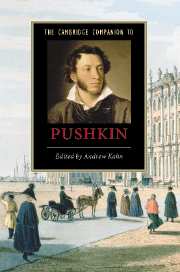Book contents
- Frontmatter
- Introduction
- Part I Texts and Contexts
- 1 Pushkin’s life
- 2 Pushkin’s lyric identities
- 3 Evgenii Onegin
- 4 Pushkin’s drama
- 5 Pushkin’s long poems and the epic impulse
- 6 Prose fiction
- 7 Pushkin and politics
- 8 Pushkin and history
- 9 Pushkin and the art of the letter
- 10 Pushkin and literary criticism
- Part II The Pushkinian tradition
- Appendix on verse-forms
- Guide to further reading
- Index
2 - Pushkin’s lyric identities
from Part I - Texts and Contexts
Published online by Cambridge University Press: 28 March 2007
- Frontmatter
- Introduction
- Part I Texts and Contexts
- 1 Pushkin’s life
- 2 Pushkin’s lyric identities
- 3 Evgenii Onegin
- 4 Pushkin’s drama
- 5 Pushkin’s long poems and the epic impulse
- 6 Prose fiction
- 7 Pushkin and politics
- 8 Pushkin and history
- 9 Pushkin and the art of the letter
- 10 Pushkin and literary criticism
- Part II The Pushkinian tradition
- Appendix on verse-forms
- Guide to further reading
- Index
Summary
Whatever else he was writing, Pushkin’s energy for lyric poetry rarely seemed to dim. If he wrote for a coterie of friends and poets in early life, he looked forward in his late poems to a time when he would be a truly national poet, and many of his more than 700 lyrics have become canonical works of Russian literature. The corpus encompasses a wide range of genres, displaying Pushkin’s mastery of the song, the poetic epistle, the elegy, epigram, the political ode, the landscape poem, the soliloquy, the poetic cycle, the fragment.
Poetry is often both a pragmatic and imaginary assertion of the self. The relationship between the first-person speaker and the author in Pushkin’s lyric poems is no less complex than in Evgenii Onegin (see Chapter 3). Whatever the connection to the lived life, lyric poems project the sense that identity is continuous but also highly precarious. Lyric poetry also projects alternative senses of identity to different, sometimes overlapping readerships. By moving through Pushkin’s career, this chapter discusses the shape of self-representation in his lyric works with a focus on the connection between poems that project the identity of a poet and poems where an inner and more private self speaks.
- Type
- Chapter
- Information
- The Cambridge Companion to Pushkin , pp. 26 - 40Publisher: Cambridge University PressPrint publication year: 2006

